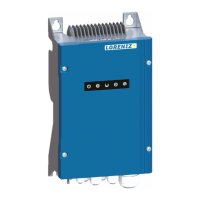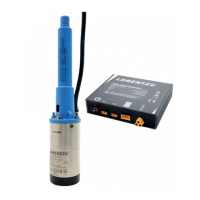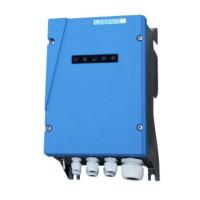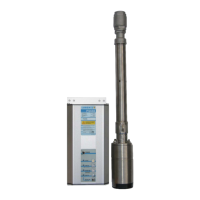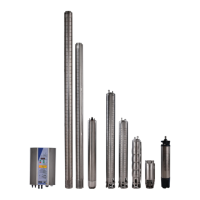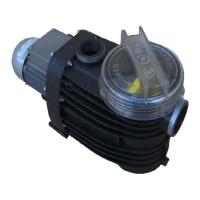Glossary of Solar Electricity and Water Pumping12.10
Basic Electricity
AC - Alternating Current, the standard form of electrical
current supplied by the utility grid and by most fuel-pow-
ered generators. The polarity (and therefore the direction
of current) alternates. In U.S.A., standard voltages for small
water pumps are 115 V and 230 V. Standards vary in differ-
ent countries. See inverter.
DC - Direct Current, the type of power produced by
photovoltaic panels and by storage batteries. The current
flows in one direction and polarity is fixed, defined as posi-
tive (+) and negative (–). Nominal system voltage may be
anywhere from 12 to 180 V. See voltage, nominal.
Current - The rate at which electricity flows through a
circuit, to transfer energy. Measured in Amperes, commonly
called Amps. Analogy: flow rate in a water pipe.
Efficiency - The percentage of power that gets converted
to useful work. Example: An electric pump that is 60 %
efficient converts 60 % of the input energy into work -
pumping water. The remaining 40 % becomes waste heat.
Energy - The product of power and time, measured in
Watt-Hours. 1,000 Wh = 1 kWh. Variation: the product of
current and time is Ampere-Hours, also called Amp-Hours
(abbreviation: AH). 1,000 W consumed for 1 h = 1 kWh.
See power.
Converter - An electronic device for DC power that steps
up voltage and steps down current proportionally (or vice-
versa). Electrical analogy applied to AC: See transformer.
Mechanical analogy: gears or belt drive.
Inverter - An electronic device that converts low voltage
DC to high voltage AC power. In solar-electric systems, an
inverter may take the 12, 24, or 48 V DC and convert it to
115 or 230 V AC, conventional household power.
Power - The rate at which work is done. It is the product
of Voltage times Current, measured in Watts. 1,000 W =
1 kW. An electric motor requires approximately 1 kW per
Horsepower (after typical efficiency losses). 1 kW for 1 h
= 1 kWh
Three-Phase AC - Three phase power is AC that is carried
by three wires. Power waves are applied in a sequence.
Three-phase is used for large industrial motors, variable-
speed motors, and brushless solar water pump motors.
Analogy: 3-cylinder engine.
Transformer - An electrical device that steps up voltage
and steps down current proportionally (or vice-versa).
Transformers work with AC only. For DC, see converter.
Mechanical analogy: gears or belt drive.
Utility Grid - Commercial electric power distribution
system. Synonym: mains.
Voltage - The measurement of electrical potential. Anal-
ogy: Pressure in a water pipe.
Voltage Drop - Loss of voltage (electrical pressure)
caused by the resistance in wire and electrical devices.
Proper wire sizing will minimize voltage drop, particularly
over long distances. Voltage drop is determined by 4 fac-
tors: wire size, current (amps), voltage, and length of wire.
It is determined by consulting a wire sizing chart or formula
available in various reference tests. It is expressed as a
percentage. Water analogy: Friction Loss in pipe.
Voltage, Nominal - A way of naming a range of voltage
to a standard. Example: A “12 V Nominal” system may
operate in the range of 11 – 15 V. We call it “12 V” for
simplicity.
Solar Electricity
Charge Controller - A device that regulates the charge
current to a battery in order to prevent overcharge. It
prevents excessive voltage and maximizes the longevity of
a battery. It may also contain other control functions (see
Low Voltage Disconnect).
Deep Cycle Battery - Batteries that are designed to
discharge as much as 80% of their capacity, hundreds of
times. They differ from engine-starting batteries by having
thicker plates and different metal alloys.
Low Voltage Disconnect - A control function in a
battery-based power system in which the load or loads are
disconnected before the battery gets over-discharged. Over-
discharge will damage a lead-acid battery. Typical settings
for a 12 V system are 10.5 or 11 V disconnect and 12.5 or
13 V reconnect.
Photovoltaic - The phenomenon of converting light to
electric power. Photo = light, Volt = electricity. Abbrevia-
tion: PV.
PV - The common abbreviation for photovoltaic.
PV Array - A group of PV (photovoltaic) modules (also
called panels) arranged to produce the voltage and power
desired.
PV Array-Direct - The use of electric power directly from
a photovoltaic array, without storage batteries to store or
stabilize it. Most solar water pumps work this way, utilizing
a tank to store water.
PV Cell - The individual photovoltaic device. Most PV
modules are made with around 36 or 72 silicon cells, each
producing about ½ volt.
PV Module - An assembly of PV cells framed into a
weatherproof unit. Commonly called a “PV panel”. See
PV array.
Solar Tracker - A mounting rack for a PV array that au-
tomatically tilts to follow the daily path of the sun through
the sky. A “tracking array” will produce more energy
through the course of the day, than a “fixed array” (non-
tracking) particularly during the long days of summer.
Voltage, Open Circuit - The voltage of a PV module
or array with no load (when it is disconnected). A “12 V
Nominal” PV module will produce about 20 V open circuit.
Abbreviation: Voc.
Voltage, Peak Power Point - The voltage at which a
photovoltaic module or array transfers the greatest amount
of power (watts). A “12 V Nominal” PV module will typi-
cally have a peak power voltage of around 15 – 17 V. The
solar array for a PV array-direct solar pump should reach
this voltage in full sun conditions, or a multiple of this volt-
age. Abbreviation: Vpp.
Pumps & Related Components
Booster Pump - A surface pump used to increase
pressure in a water line, or to pull from a storage tank and
pressurize a water system. See surface pump.
Centrifugal Pump - A pumping mechanism that spins
water in order to push it out by means of centrifugal force.
See also multi-stage.
Check Valve - A valve that allows water to flow one way
but not the other.
Diaphragm Pump - A type of pump in which water is
drawn in and forced out of one or more chambers, by a
flexible diaphragm. Check valves let water into and out of
each chamber.
Float Switch - An electrical switch that responds to
changes in water level. It may be used to prevent overflow
of a tank by turning a pump off, or to prevent a pump from
running dry when the source level is low.
Float Valve - A valve that responds to changes in water
level. It is used to prevent overflow of a tank by blocking
the flow of water.
